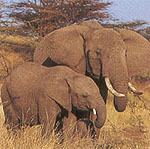AFRICAN ELEPHANT

How to Recognize
Elephants are the largest land mammal with bulls standing as high as 11 feet and weighing 7 tons! They are gray in color and have trunks that grasp, drink, spray, and trumpet. They have huge, leathery ears which stand out when annoyed. They use their long tusks as both tools and weapons, and they get six sets of molar teeth in a life time.
Habitat
Elephants can be found in a wide range of habitats that have shade and water (from semi-desert to rainforest and grasslands).
Behavior
Nocturnal and diurnal. Elephants can sleep as little as four hours a day. They usually live in small family groups of between 10 to 20 related females and their offspring. They have huge home ranges and make seasonal movements. These family groups frequently congregate with other herds at common water or food sources.
Herds are very sociable and vocal, greeting each other (and other herds) with trumpeting, pirouetting, and placing their trunks in each other’s mouths. They also communicate by a low frequency sound that humans can't hear which travels up to six miles. This allows them to keep in touch with each other and to advertise when they are in estrus.
Their societies are matriarchal and herds are dominated by the oldest female. Young bulls are ousted from the herd when they are 10 to 14 years old and either drift between family units, join bachelor herds, or live alone. They join the female herds when they are in estrus, and a female may mate with many bulls. They usually live for 60 to 70 years.
Bulls get “green penis syndrome” and bad-tempered when they come into “musth” for one month per year. This is when liquid oozes from the temporal gland on their heads which leaves dark stains on the side of their faces. A bull's massive penis turns green, dragging on the ground dribbling and exuding a strong smell. Several bulls compete for dominance and when one eventually mounts a female for a knee-trembling sixty seconds, other females gather around with much trumpeting and ear flapping.
Elephants are almost human in complexity. They are truly charismatic, showing signs of intelligence and compassion. For example, they will use their tusks to short-circuit an electric fence to reach some fruit. A sick or wounded elephant is sometimes propped up by two comrades. If it should fall, they'll break their tusks in an effort to raise the fallen elephant back up. Elephants recognize their dead, feeling the bones while standing quietly. They cover their dead kin with dirt and branches, and they have even done this to humans they have killed.
Breeding
A single calf is born after a 22-month gestation which takes place mostly in the rainy season. The calf may remain with its mother for ten years. The breasts on females are located between the front legs, and they stop calving at around the age of 45.
Feeding
As browsers and grazers, an adult’s average daily food intake is about 330 pounds of grass, leaves, bark, and other vegetation. They drink and bathe daily.
They recycle huge quantities of vegetation and reshape entire landscapes.
Enemies
Lions and humans. Lions will take down a young elephant. Poachers slaughter elephants for their tusks.
TOP OF PAGE
Copyright © 2002, Dawn M. Dalton.
All rights reserved.
**LINKS**
WHERE?
WHY?
ITINERARY
PLAN YOUR TRIP
GETTING THERE
LONDON
KENYA
UGANDA
SAFETY
ITEMS BOUGHT
STAYING HEALTHY
COMMENTS
HOME
BHS HOME
---Animal Facts--
Baboon
Buffalo
Cheetah
Chimpanzee
Crocodile
Eland
Elephant
Gazelle
Giant Forest Hog
Giraffe
Gorilla
Hippopotamus
Hyena
Hyrax
Impala
Jackal
Lion
Mongoose
Monkey
Ostrich
Rhinoceros
Topi
Uganda Kob
Warthog
Waterbuck
Wildebeest
Zebra